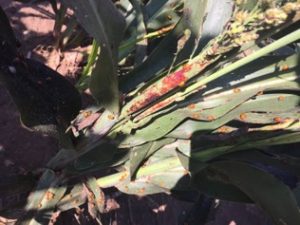This tip was provided by:
Calvin Trostle, Extension Agronomy, Lubbock, 806-746-6101, ctrostle@ag.tamu.edu
South & Central
Sugarcane Aphid Online Webinar Presentations for South & Central Texas
On September 26, Dr. Robert Bowling, AgriLife Extension entomologist, and Dr. Mike Brewer, AgriLife Research entomologist, both located at Corpus Christi, led a series of online webinars to update producers and industry on sugarcane aphid management. The webinars are posted at https://ccag.tamu.edu/south-texas-sugarcane-aphid-management-conferencewebinar/ You can watch any of the nine presentations at your leisure based on your need. The total amount of programing is about 3 hours. Updates are provided from this season’s insect observations, control strategies, etc.
Additional information on sugarcane aphid hybrid tolerance will be coming soon from extensive hybrid trials both in South & Central Texas as well as the High Plains. I am pleased to report there appears to be many hybrids now that do indeed exhibit significant tolerance to SCA. Foliage remains green, even if there is heavy SCA with honeydew, and heads generally fill adequately even if not sprayed in some cases.
Current Texas High Plains SCA Situation
Most reports I received through last week note that SCA is in great decline or now even gone from many fields. I last found any significant numbers of SCA (some leaves still over 1,000 aphids per leaf) in our Lubbock AgriLife hybrid trial on Monday, Oct. 3—all I had to do to find them was look for the lady beetles (see figure below). By Friday when I rechecked the same spots, the SCA were essentially gone.

Fig. 1. High lady beetle population cleaning up remaining late-season sugarcane aphids in grain sorghum on October 3, 2017. All SCA were gone by October 7. (Lubbock, TX)
AgriLife Extension entomologists note that producers still need to track potential SCA numbers in their fields until they receive a freeze. If you still have SCA issues but are needing to harvest, the use of either Roundup or sodium chlorate can be applied to dry the crop, but limited research suggests these treatments drive SCA into the head, and that may be worse. A producer might include malathion at a low rate to exert partial control on late-season SCA in the head, but keep the post-harvest interval short. If you still have SCA but want to apply a harvest aid, consult with Extension entomologist Dr. Ed Bynum, Amarillo, (806) 677-5600, ebynum@ag.tamu.edu








